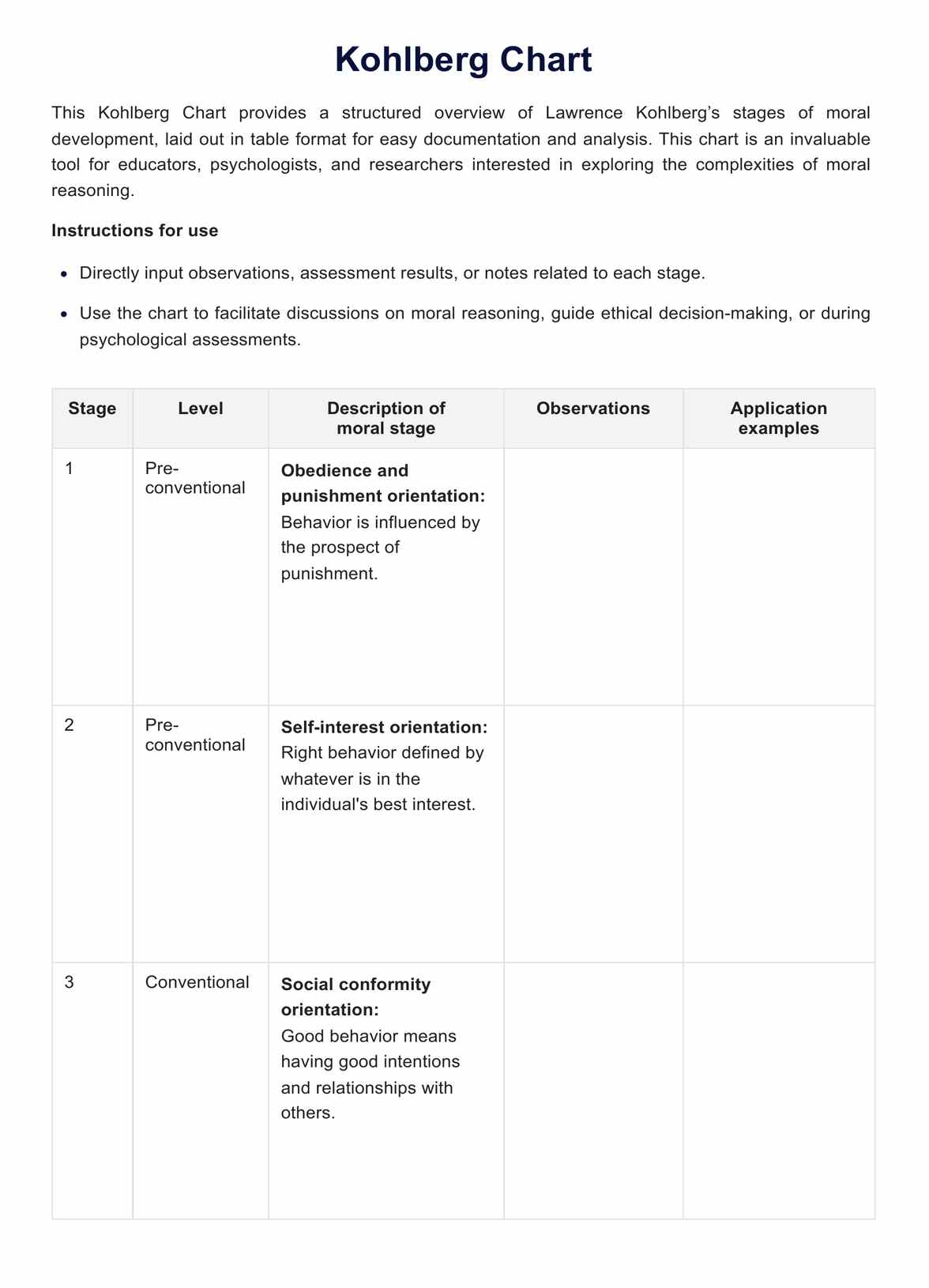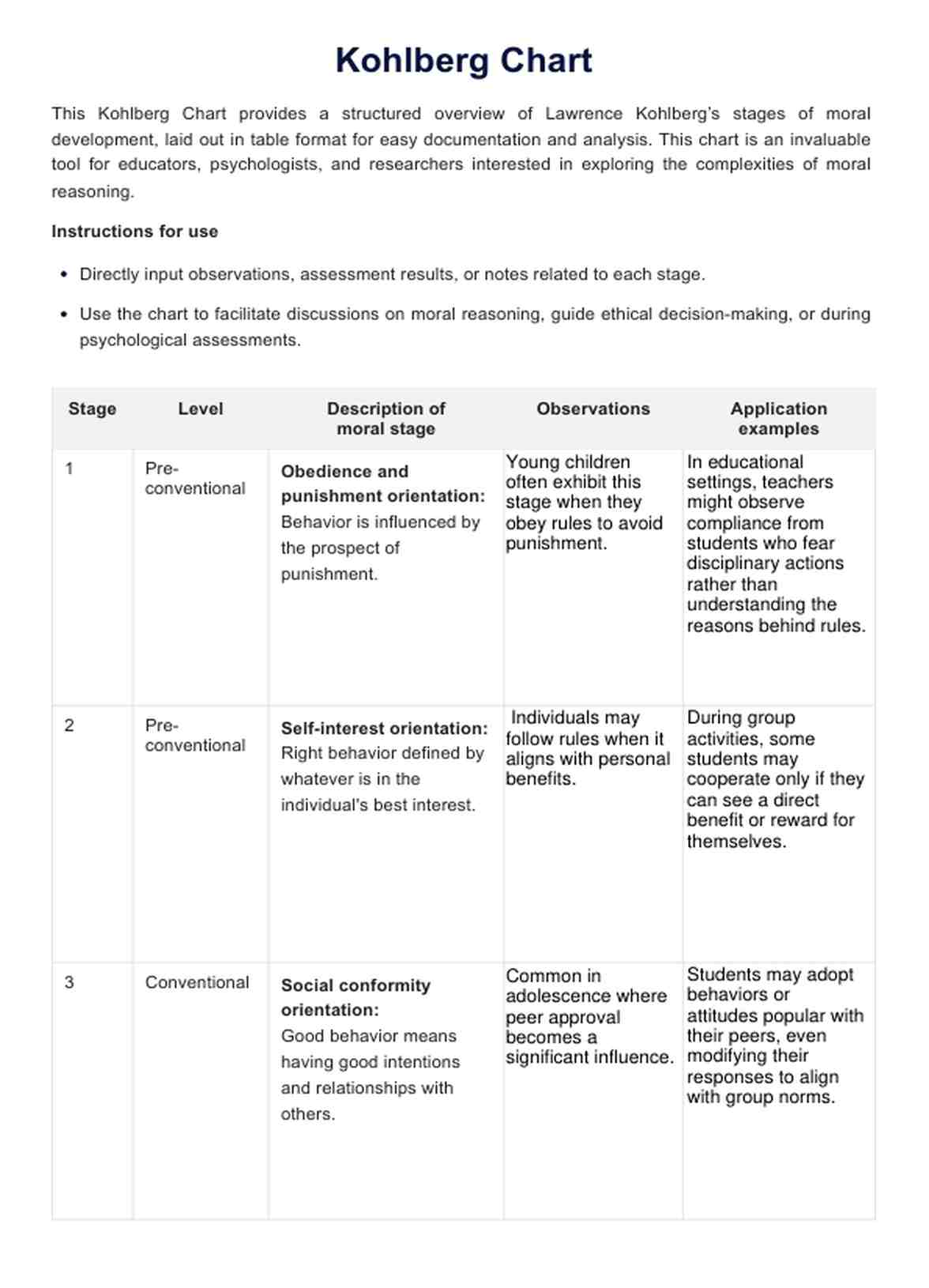Kohlberg Chart
Explore Kohlberg's theory of moral development through our detailed Kohlberg Chart. Understand the stages and download our free Kohlberg Chart template.


What is Kohlberg's theory of moral development?
Kohlberg's theory of moral development, developed by psychologist Lawrence Kohlberg, is a framework that outlines how individuals progress in their understanding of right and wrong as they grow and mature. This theory suggests that moral reasoning, the basis for ethical behavior, has six developmental stages, grouped into three levels: pre-conventional, conventional, and post-conventional. Each stage represents a different approach to judging moral issues and dilemmas people face.
Kohlberg Chart Template
Kohlberg Chart Example
The 3 categories of moral reasoning
Kohlberg's theory of moral development categorizes the evolution of moral reasoning into three distinct levels of moral behavior, each comprising two stages. This theory highlights how individuals progress from basic, self-centered ethics to complex, moral understanding based on universal ethical principles.
Pre-conventional morality (avoid punishment & self-interest)
Here are the stages of pre-conventional morality:
Stage 1: Obedience and punishment orientation
In this initial stage, an individual's moral reasoning is primarily driven by the desire to avoid punishment. Actions are considered 'wrong' if they lead to punishment; 'right' actions avoid such consequences. This stage reflects an external view of morality, where social rules are followed only to evade negative outcomes, not from any understanding of right or wrong.
Stage 2: Individualism and exchange
At this stage, the concept of right behavior shifts to serving one's interests, but with a more nuanced understanding that others also have their interests. Here, moral reasoning is based on individualism and exchange; actions are judged based on how well they serve individual needs in a somewhat reciprocal manner. The focus is still largely self-centered but begins incorporating a sense of fairness or equal exchange.
Conventional morality (good boy attitude and law, and order)
For conventional morality, there are two stages:
Stage 3: Good interpersonal relationships
During this stage, individuals value trust, caring, and loyalty to others as the basis of moral behavior. Morality is governed by conforming to the social norms and roles that ensure good relationships and societal approval. The focus of moral decisions shifts from self-interest to fulfilling social expectations and roles, like being a good sibling, friend, or citizen.
Stage 4: Maintaining the social order
Here, morality is defined as maintaining the social order. Respect for authority, fixed rules, and laws dominate this stage of moral development. Individuals at this stage believe that societal laws uphold order and that maintaining this order is morally right. The reasoning extends beyond personal relationships to a broader understanding of community and societal stability.
Post-conventional morality (social contract & principled conscience)
Lastly, post-conventional morality stage has two stages:
Stage 5: Social contract and individual rights
In the fifth stage, individuals think about societal welfare, recognizing that legal and societal norms might conflict with individual rights. Moral behavior involves upholding rules that are in the community's best interest and are agreed upon by the populace. People at this stage value laws but recognize that they should change when they do not promote the general welfare.
Stage 6: Universal principles
The final stage of moral development involves reasoning based on universal ethical principles and abstract reasoning. Morality is now governed by internal moral principles that transcend laws or the expectations of others. Individuals at this stage of moral education are guided by self-chosen ethical principles they believe to be right, even if they conflict with laws and social agreements.
These stages illustrate the complexity and depth of our moral development as we grow and interact with the world, highlighting a gradual shift from a concrete to an abstract understanding of living morally in a complex world.
Understanding these stages aids educators, psychologists, and others in supporting individuals as they navigate the intricacies of moral reasoning and ethical dilemmas in various aspects of life.
What is a Kohlberg Chart?
A Kohlberg Chart is a visual tool used to outline the different stages of moral development as defined by Lawrence Kohlberg. This chart helps students, educators, and psychologists visualize and understand the progression of moral reasoning from basic, self-centered thinking to advanced, principle-based moral judgments.
How does Kohlberg's theory help psychologists?
Kohlberg's theory is instrumental in developmental psychology, providing a valuable framework for understanding how moral understanding matures. Psychologists use this theory to assess moral reasoning skills and to guide individuals in ethical decision-making. It's also used in educational psychology to develop programs that enhance students' moral development.
Benefits of using our Kohlberg Chart template
Download our comprehensive Kohlberg Chart template to gain a detailed and structured overview of each stage of moral development based on Lawrence Kohlberg's influential theory. This visually organized template is essential for educators, psychologists, and researchers looking to deepen their understanding and application of moral and human development concepts. Here’s how you can utilize the Kohlberg Chart template effectively:
- Track the development of moral reasoning in educational settings: Educators can use the Kohlberg Chart to monitor and assess the progression of moral reasoning among students. By mapping out where students typically fall within the stages, educators can tailor their teaching methods and curricula to better suit their students' developmental needs, fostering a more nuanced understanding and discussion of moral issues.
- Facilitate discussions about moral dilemmas and ethical decision-making: The Kohlberg Chart is an excellent resource for sparking in-depth discussions about complex moral dilemmas. It can help participants understand the different levels of moral reasoning and encourage them to explore various ethical perspectives. This can be particularly valuable in workshops, seminars, or classroom settings where ethical decision-making is a key curriculum component.
- Aid in psychological assessment and research: For psychologists and researchers, the Kohlberg Chart provides a framework for assessing the moral development of individuals or groups. This tool can be instrumental in longitudinal studies tracking how moral reasoning evolves over time or in therapeutic settings where understanding a client's level of moral development might inform treatment approaches.
- Developing personalized educational and therapeutic programs: With insights from the Kohlberg Chart, professionals can design personalized educational or therapeutic programs that address specific stages of moral development. This targeted approach can help address specific moral reasoning challenges, promote ethical development, and support individuals in navigating moral dilemmas more effectively.
- Enhance professional development workshops: For organizations looking to enhance ethical standards and practices, the Kohlberg Chart can be a foundational tool in professional development workshops. It helps employees identify their stages of moral development and understand how their moral reasoning impacts their professional and personal interactions.
By downloading our Kohlberg Chart template, you can engage with moral development theory in a practical, impactful way, enhancing educational outcomes, psychological assessments, and ethical discussions across various contexts.
Whether in the classroom, the research lab, or the therapy room, this tool will help illuminate the complexities of moral development and foster a deeper understanding of ethical principles and their application in everyday life.
Commonly asked questions
Understanding these stages of moral judgment can help individuals recognize their moral reasoning and improve their decision-making in complex moral situations.
Critics argue that Kohlberg's theory overemphasizes justice and doesn't account for other values like compassion, caring, and interpersonal relationships in moral reasoning.
Not everyone reaches the post-conventional level; it requires cognitive development, maturity, and exposure to various viewpoints and values.

.jpg)























-template.jpg)













































































